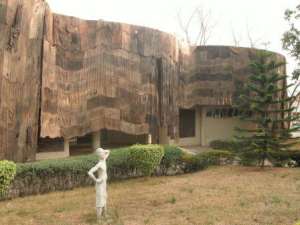
26 year old Ibrahim Mahama is of a new generation of artists that is redefining what art can be, how it is exhibited and how it interrogates our relationships with ourselves and our surroundings.
Whether kente, adinkra, or wax print, cloth has long been a semiotic, value-transferring art form in Ghana.
West African born, internationally acclaimed artists, like El Anatsui and Yinka Shonibare have carried on and reinvented this tradition by using bottle tops to take on the form of Kente or wax print to usurp Western historical and aesthetic narratives.
Ibrahim goes a step further by incorporating the provenance, narrative and context of the cloths in his work.
He creates out of a commonplace material. Jute sacks imported by the Ghana Cocoa Board and repurposed by charcoal sellers are again repurposed by the artist, and exhibited in the very places they are sold.
His epic installations move out onto the streets, into marketplaces, under abandoned railway bridges, rendering what is unseen – layers upon layers of rubbish, degradation normalised and neglected by inhabitants and their government – visible.
In his most ambitious work to date, Ibrahim covers the KNUST Museum, both inside and out, in jute cloth to give more obvious form to questions, such as – Is this Art? Who is the Artist? Is this the place for it? What is the relevance of the museum model? And what does it all mean anyway?
Ibrahim describes art as an inherent complex phenomenon and for him getting confused as a cursory onlooker is another way of contributing to the creative work “because you are causing them to think much more deeply about things that they wouldn't have felt deeply about”.
The exhibition is staged in collaboration with the cultural research platform ANO, which hopes to provide a context for his work through writing, curation, discussion and an upcoming film.
“I think what people can come and take away is an opening of mind, of soul, and of questioning”, said Nana Oforiatta-Ayim, Curator and collaborator for the exhibitor. “Culture is the very foundation of society and without culture we're nothing, so exhibitions like this one begin to bring arts to our lives, begin to bring these questions into our lives and engender more discussion; and I think the more and more this happens, the deeper look into and awareness of ourselves as a growing society becomes”.
It took Ibrahim about eight months to put the works together and he is hoping to put more of his creations out in public in coming months.
“We were living in arts many years ago, through dance, culture, tattoo and others”, he observed. “It's not something that you actually do that becomes an object that people can actually worship or becomes sacred, it's something that lives in you and translates from every movement, every sweat and every drop of your blood”.
Story by Kofi Adu Domfeh




 Former Kotoko Player George Asare elected SRC President at PUG Law Faculty
Former Kotoko Player George Asare elected SRC President at PUG Law Faculty
 2024 elections: Consider ‘dumsor’ when casting your votes; NPP deserves less — P...
2024 elections: Consider ‘dumsor’ when casting your votes; NPP deserves less — P...
 You have no grounds to call Mahama incompetent; you’ve failed — Prof. Marfo blas...
You have no grounds to call Mahama incompetent; you’ve failed — Prof. Marfo blas...
 2024 elections: NPP creates better policies for people like us; we’ll vote for B...
2024 elections: NPP creates better policies for people like us; we’ll vote for B...
 Don’t exchange your life for wealth; a sparkle of fire can be your end — Gender ...
Don’t exchange your life for wealth; a sparkle of fire can be your end — Gender ...
 Ghana’s newly installed Poland train reportedly involved in accident while on a ...
Ghana’s newly installed Poland train reportedly involved in accident while on a ...
 Chieftaincy disputes: Government imposes 4pm to 7am curfew on Sampa township
Chieftaincy disputes: Government imposes 4pm to 7am curfew on Sampa township
 Franklin Cudjoe fumes at unaccountable wasteful executive living large at the ex...
Franklin Cudjoe fumes at unaccountable wasteful executive living large at the ex...
 I'll 'stoop too low' for votes; I'm never moved by your propaganda — Oquaye Jnr ...
I'll 'stoop too low' for votes; I'm never moved by your propaganda — Oquaye Jnr ...
 Kumasi Thermal Plant commissioning: I pray God opens the eyes of leaders who don...
Kumasi Thermal Plant commissioning: I pray God opens the eyes of leaders who don...
